Leaving the Highlands behind us, we entered the flow of tourist vehicles on the N1 (Ringroad). The northern and north-western parts of Iceland became now our focus.
The north and north west parts of Iceland consist of fjords divided by peninsulas, with little habitation due to its geography and remoteness. Some areas are even unknown or hardly visited by Icelanders themselves. An interesting, but a little challenging, F-road goes through the middle of the first peninsula following and crossing multiple times a large river.
Many F-roads cross farmers land (grazing grounds for their sheep), which are fenced areas. Animal-road-grills and gates have to be passed when following these roads. It’s a custom Icelanders are used to and when you open the gate, you close it after you passed it, to avoid the sheep going into another field.
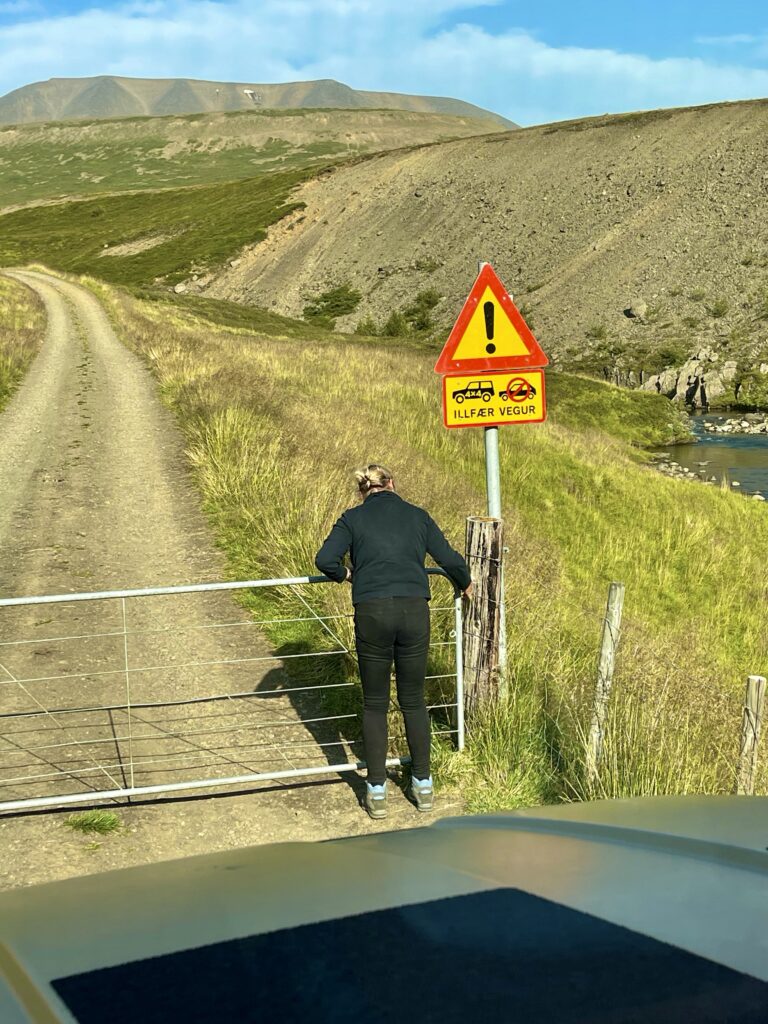
The F899 goes over narrow mountain edges, through deep valleys and passes steep mountain slopes. Several small and large river crossings separate the different parts of road. Along the road we saw multiple sign posts with names of farms, which once dotted this parts of the peninsula along the river, some dating back to the 17th century. The contours of the foundation or an elevated mount are often the only visible site of what was once home of a family of die-hard farmers, who tried to survive in this harsh isolated location.

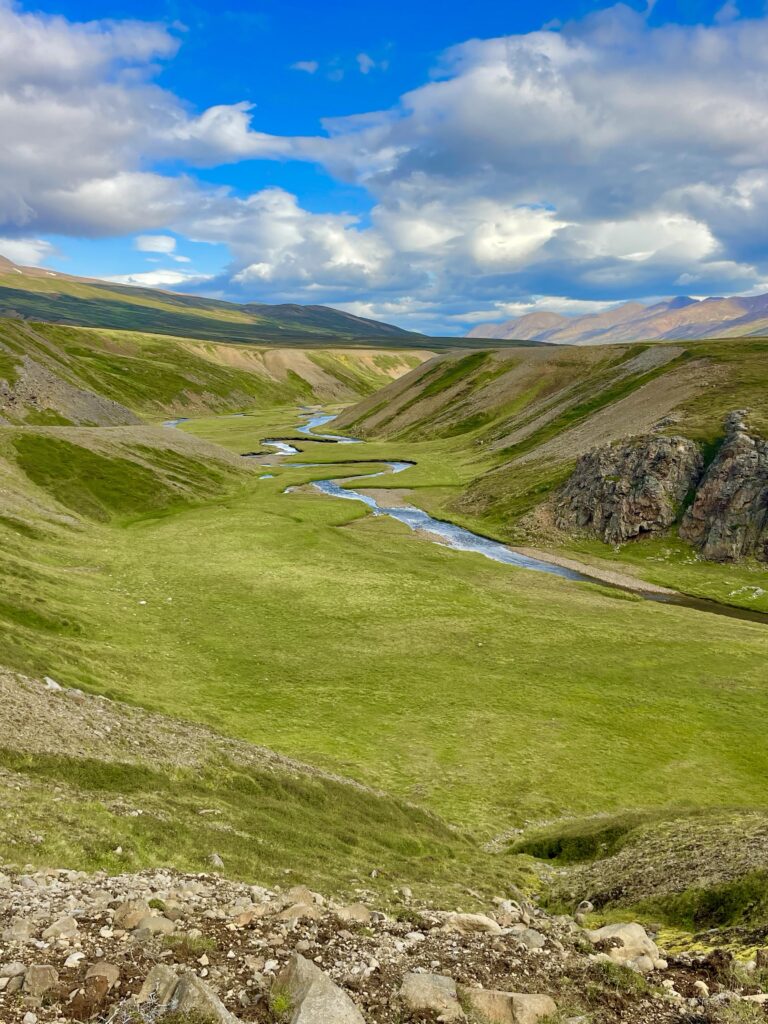

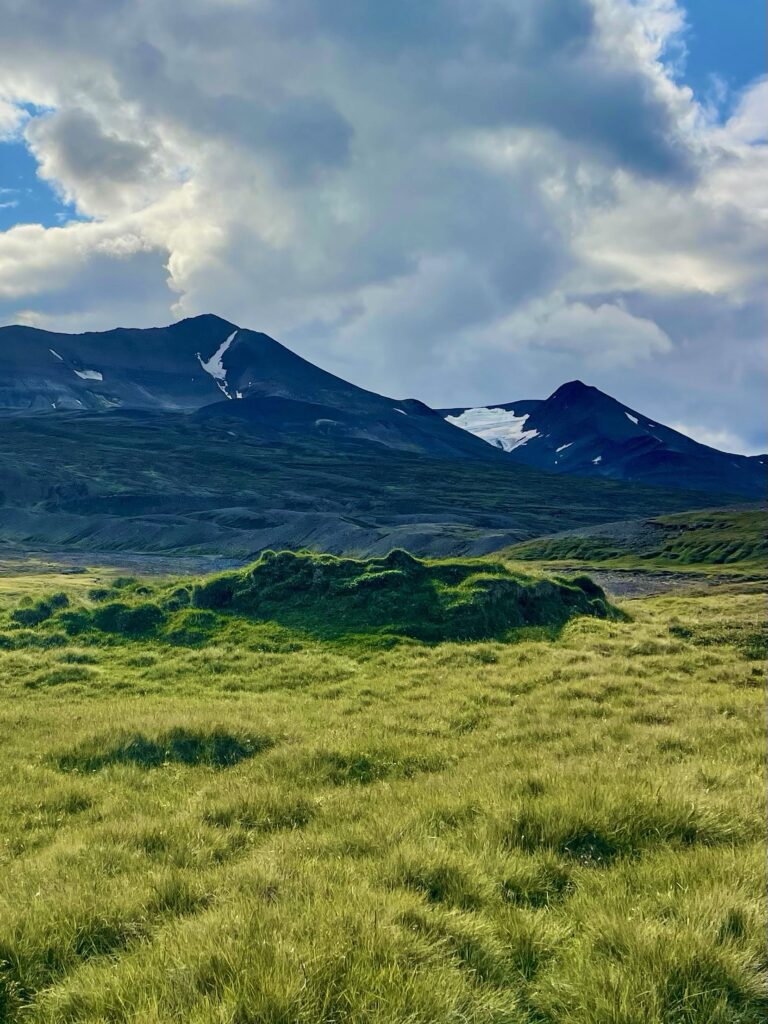
Half way in a small valley we camped along one of the contributory rivers with a view towards a mouth, where once stood a small farm house. We could imagine the beauty of living in such a beautiful green valley with its small rivers, especially in the summer. But in the winter (like most of the isolated farms in Iceland), it must have been tough, with long dark days and nights, cold and lonely, with paths and mountain passes blocked by a thick layer of snow.

The F899 ended on a big beach covered with rocks, which lost their sharp edges over the years by the battering waves of the ocean. We spent a day and a night on this beach, which was home to many birds and the occasional seal, who – curious as they are – came close to the beach to figure out who was watching them. Although a track was continuing over the rocky beach into the mountains, it would be too heavy for the truck. Instead we hiked the track for an hour or two, reaching the most northern tip of the peninsula. From here we could see the small island of Flatey with its few houses and a small church. Yes, some people even went further into the remoteness. The most remote spot and also the most northern part of the Iceland territory is the island of Grimsey, which is located 40km north of main land Iceland.

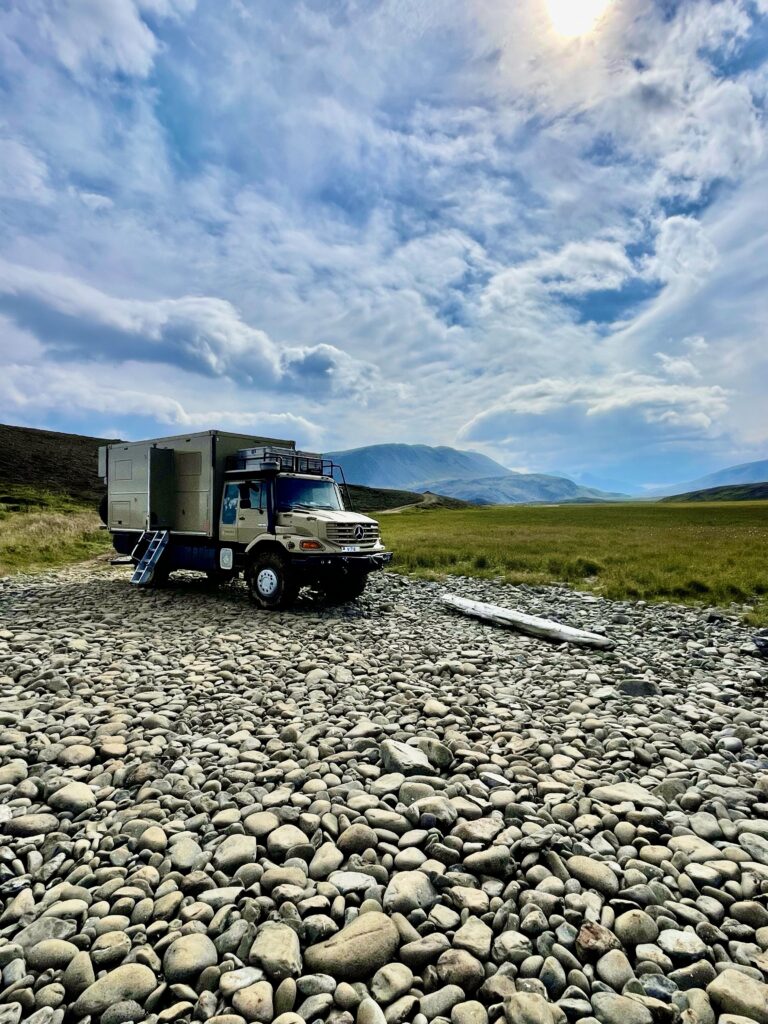


Since it was a long weekend in Iceland, a couple of Icelanders made day trips to the north and so reached our location as well. For some it was also the first time to be at this pristine beach and we had some nice conversations with them, especially after offering them a cup of coffee.

Returning from our hike, we were pleasantly surprised to see Tony and Annick parked next to us! Unplanned, they also made it through the F899 and ended up on the same beach as us. We hung out for the night together, exchanging more travel stories and having some drinks and bites!

After Tony and Annick left the next morning, we packed up and drove back on the beautiful F899. On the way, having a coffee break, Peter and Denise in the black Zetros came by, yes, they were driving the same F899 as well. Ofcourse, they joined our coffee break, that was really nice again!
When continuing our drive, a local elderly couple overtook us in their big American passenger van, with the huge off-road tires. Then they had a flat tire and asked if I could pump it up with my truck compressor, which I did with pleasure. Later we found them again along the road with the same tire completely flat. This time he tried (and succeeded) fixing the tire. Icelanders are well prepared and skilled in fixing their flat tires. This 82 year old gentleman crawled under his bus with a plug and fixed it. Spare tires they hardly carry. In worst case scenarios, they call a family member or friend to bring the spare. If you see the tires they have mounted on these vans, buses or jeeps, it’s understandable that they often don’t carry spare tires with them….they are so huge!


Back on the N1 , we drove to the next peninsula where we wanted to try the hot water pools at a small place called Grettislaug. A unique place at the end of a small gravel road with a campsite, a small building which functioned as reception, souvenir shop and bar. The interior was very rustic and cozy, and the guy in charge could be Merlyn (from the movie Lord of The Rings). Since he was of the opinion that our truck would be too heavy for the soft grass campsite, he gave us the best spot on the entire campsite, right on the water side near a collapsed pier.

Throughout Iceland you will find hot water springs, some uncultivated, some cultivated, just along the road and free for public use, and others part of more fancy establishments like spa hotels. The one at Grettislaug was part of the campsite and not completely cultivated with still lots of rocks visible. We met some nice people in the hot spring, who we later had some drinks with in the bar. A friendly Scottish girl was celebrating her birthday in the hot pool, we all had a lot of fun together.


One of the most remote hot springs in the West Fjords is located at Krossness, which was not so easy to reach. We had to do some serious driving on a narrow gravel road, to reach it. This hot spring was turned into a hot water pool, managed by a nice lady from the Tsjech Republic. Upon arrival there, we were surprised to see……..Tony! Like he was expecting us. Parking was limited so he had arranged to have another camper truck move out, so we could park. By the time we parked, everybody was out of the pool and gone.


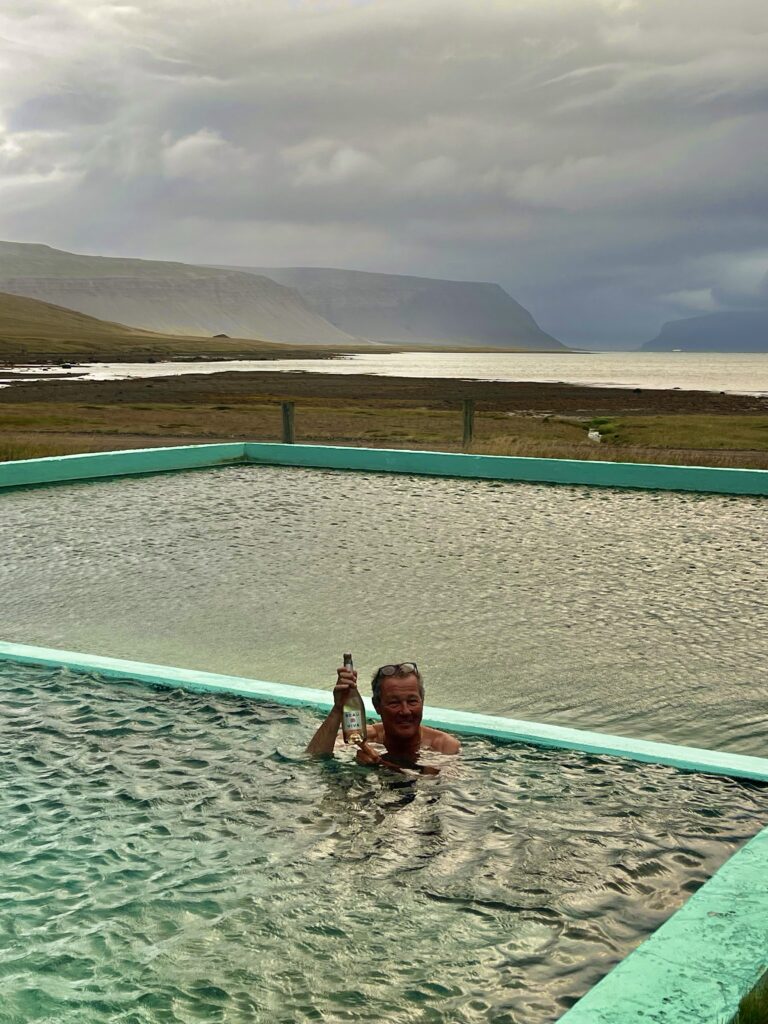
With a bottle of champagne, we indulged ourselves in hot earthy mineral water and from the edge of the pool, we had a great view over the Atlantic Ocean, looking north towards the Arctic. Moments you never forget!
Staying on the parking nearby the hot water pool (since everybody had left), we tried to spend the night right there. But the beautiful quiet evening we had in the pool, changed into a fierce stormy night. The wind became so strong, that I was even afraid that he truck would fall over. Not only that, the noise of the hauling wind made us unable to sleep. At 3.00 in the morning, I decided to drive down to a nearby harbor where I found some sheltering. Marja stayed in bed while I drove through the darkness (first time I was driving in the dark since our departure from The Netherlands), on a narrow winding mountain road, while the truck was shaking from the heavy wind. She told me she felt like beiing seasick in there!
The next morning I could better see where I had parked the truck in the dark night and how I got there. I saw now that I missed a 2 meter high ramp and low hanging roof and also some sharp obstacles piled together on the road into the harbor. Luck had been on my side that night, that is for sure! (The boat parked next to me, secured with heavy weights, indicated the mighty forces of the storm the night before).

It was now a rainy day and driving around wouldn’t be fun. So, we drove the short distance back to the hot pool and followed the road from there until it ended. Cloudy skies and a drizzling rain was forecasted for the whole day, so we dressed ourselves accordingly and hiked from this end of the road onwards. We had to cross private property sometimes to follow tracks, which are allowed to be used by the public, as long as you stay on the track and close the gate(s) behind you. Walking through high wet grass on a trail which seemed hardly used, we reached a point where going any further was impossible, unless you would either swim along the cliffs or you would do some serious mountaineering. The end (the cliffs) was reserved for the many birds flying very low over us, like showing us…..we can go further…..you cannot!



Soaking wet (despite our rain attire), we returned to the truck at the end of the morning. An afternoon of rest, reading and writing was left. So we spent the rest of the day at this far away spot on the dead end road.
On the way back we stopped at a large abandoned fish factory in a small village. Once a state of the art factory for the fish industry, now a statement of poor planning or a changing natural environment. Strategically located not far from large fishing grounds, it was suppose to be operational for many years. However, the large amounts of fish meant to be caught and to be processed in the factory, disappeared rapidly. Whether this was due to overfishing or climate change (fish are sensitive for water temperatures), that is unknown. Result is that the factory closed down and its buildings fell in decay. Parts are still in use by an artist, as a gallery. Most people who worked in the factory left the village. Those remaining, are trying to boost local tourism with a small hotel at the center of the village, and organizing tours and hikes.

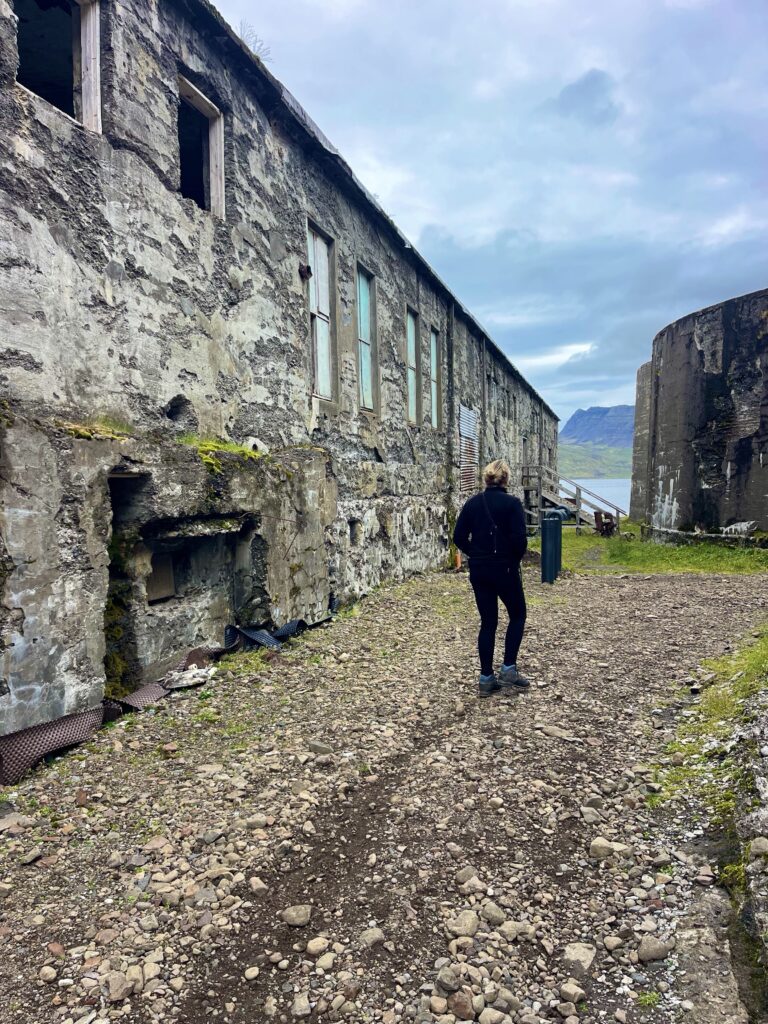

It was a while ago since we got stuck somewhere in the sand or mud. Parking next to a track in a fjord for the night was not a good idea it turned out the next day. The track itself is covered with a thick layer of compacted gravel, but underneath there was the soft muddy turf ground.
Lowering the tire pressure and engaging the 4×4 didn’t help, it even got worse. Time to take off the sand ladders and taking out the shovels. We almost forgot how it was to get stuck, but we were sure we would manage to get out. The thick grass sods were very tough to get out with the shovels in order to get the sand ladders under the tires, but with great efforts we got the sand ladders in place. After a second try we got the truck back on the track. The mud was all over, so at the next gas station, we had some cleaning to do!


On several occasions driving along the northern coast line of the peninsulas we either saw them directly, or were made aware by signs, that seals or seal colonies were nearby. Seals are now protected species in Iceland, although some hunting still occurs, eg when they are threatening the salmon farms. Before hunting seals was part of daily life for fishermen and farmers alike, providing food and skins. Now, they are part of the tourism sightseeing business in Iceland. Also during the passing of the other fjords of the West Fjords we say them often.
Driving through the West Fjords – after the Highlands the second most remote area in Iceland – reminds us a lot of the Faroer Islands. Long stretches of mountain ridges dividing several fjords. The roads run often along steep mountain slopes and steep cliffs, where rocks can easily fall on the roads, causing havoc. Waterfalls are far too many to mention, one even nicer and more impressive than the other. Sadly also here we see the many salmon farms, mostly owned by Norwegian salmon farming companies, which cause wide spread pollution of the marine environment and are threatening the wild salmon population.


Due to its isolated location in the north west of the country, many small farms have been abandoned. Succesion by younger generations was often not desired as the small scale and the logistic cost could not support farming life. Many farm houses have been transformed into summer or vacation houses for the Icelanders living in the capital. Due to its remoteness and natural beauty, the West Fjords are a popular destination for Icelanders, escaping the capital. An old farm along our route was transformed into a coffee house, where the atmosphere of the old days has been kept alive.



On the most northern peninsula of the West Fjords, we were able to drive into an area which was once covered by ice from a retreating glacier. Parking at about an hour walk from the foot of the glacier behind a glacier weir wall. Walking a path marked by stone cairns, crawling over rocks and bolders, jumping the many streams of melt water and avoiding quicksand areas, we realized at a certain moment that we were already on the glacier ice itself! Black dust, gravel and big rocks over time had covered the ice, which became invisible. The many cracks also became covered and these are the most dangerous parts of the glaciers. The glaciers are also melting from underneath due to flowing warmer water, which generates the so called ice caves. The glacier we walked on is part of the Drangajokull ice cap of peninsula. Water falls coming down from all sides of the ice cap. One of the waterfalls even made a hole in the glacier, where the water has over time “drilled” a tunnel under the glacier and coming out at the foot of the glacier which had now a large open cave. Due to the fact that substantial effort has to be put in to reach this area, we were all by ourselves to admire this natural phenomenon. Walking back we found in the middle of the rocks a small waterfall which poured its water into a small rocky pool surrounded by layers of colorful basalt stone. Testimony to the artistic skills of mother nature.



Returning to the truck we realized the uniqueness of our camp spot. Out of sight and with a wonderful view over the glacier and partially over the ice cap. There was no wind and the temperature was not too cold. A perfect place and time for an outdoor shower after our beautiful but enduring hike!

Later into our trip around Iceland, we would even be able to drive the truck all the way to the edges of one of the many retreating glaciers. The glacier of the Vatnajokull.ice cap, is popular by tourists, as huge specially designed truck buses with large tires (with spikes), drive on the glacier ice and bring tourists to a large man made ice tunnel in the glacier ice. Since the route on the glacier was driven over by 15ton trucks, we dared to walk over the glacier ice as well. Small pieces of wooden sticks were placed at the beginning of the season, to guide the drivers of the truck buses over the glacier ice. And when walking on the ice, we saw bright colored markers, indicating the large cracks and holes in the ice, which could easily swallow humans, small cars or even half a truck!. Only if you fly over a glacier, you can see that the glaciers are not one straight smooth piece of ice, but many horizontal standing ice sheets, like you break open a round piece of fruit.

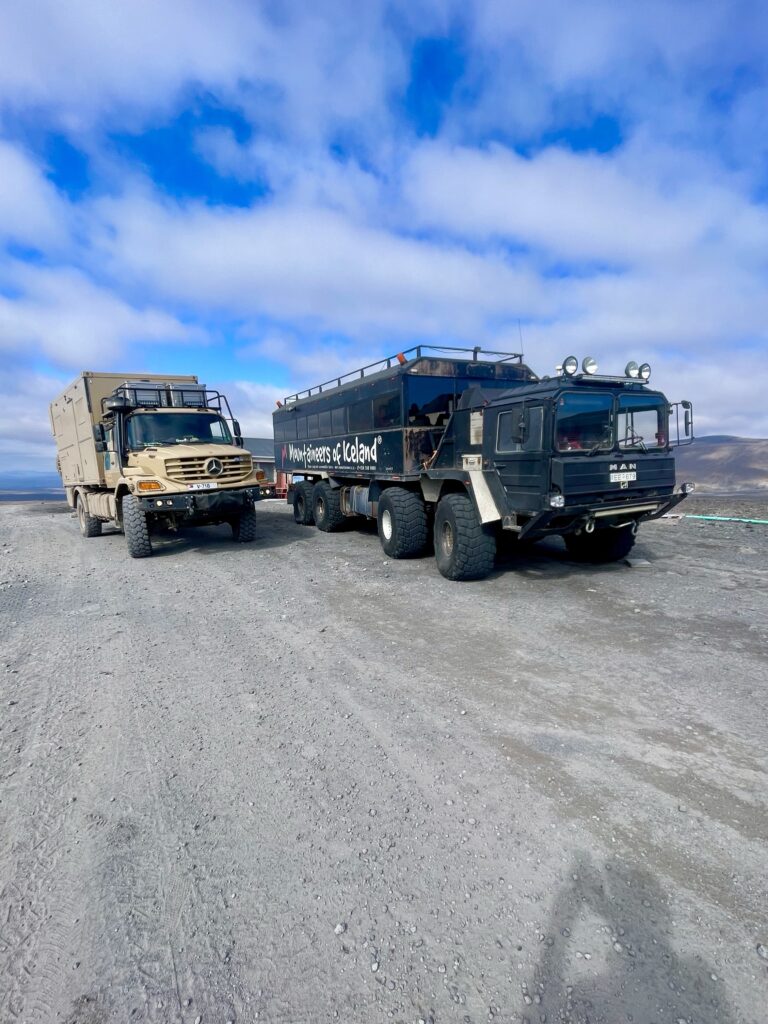



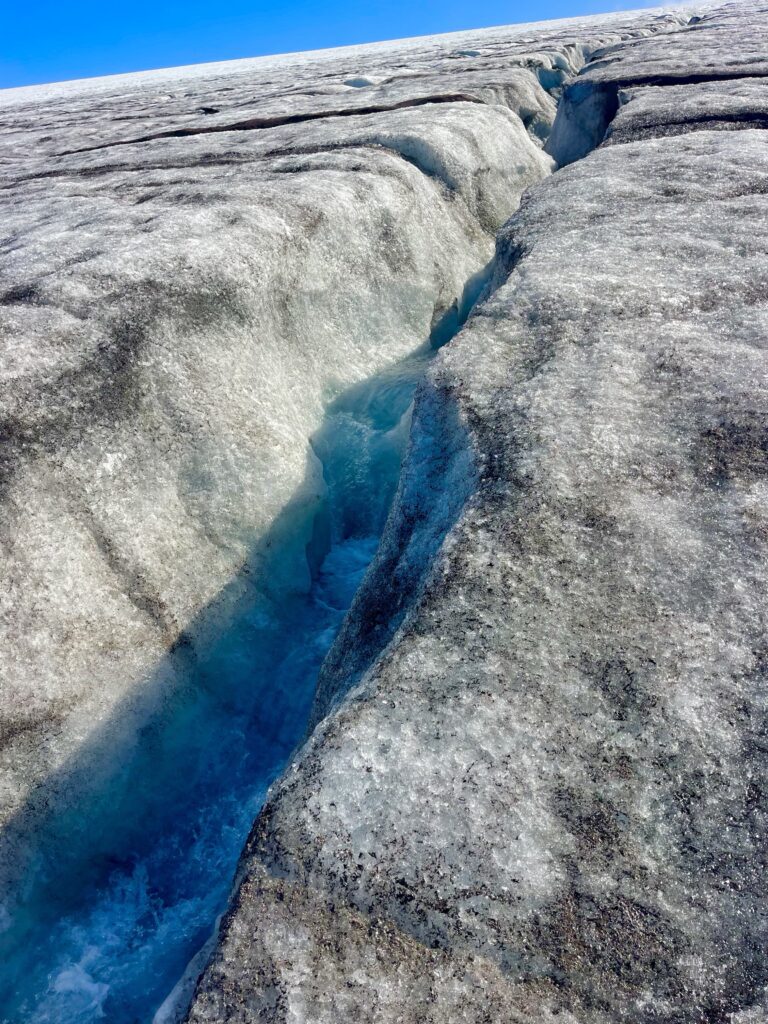

Due to its natural beauty, but also the lack of economic development, a lot of effort is placed in developing the tourism sector. The capital of the West Fjords is now an important cruise ship destination where three to four cruise ship can be moored for the day. Passengers flood the streets, often to the chagrin of the local population, who consider them a nuisance, from which they see little benefit. Tour operators on the other hand, drag the passengers into buses, bringing them to waterfalls, view points and on tasting tours. One wonders if the West Fjords are in need of this type of mass tourism.

High above a cliff, where the Icelandic Coast Guard has an observation station, a large overhanging deck (manufactured in Poland), gives tourist a little adrenaline shot, when looking down through the mess floor. Yes, destinations have to be filled with action and excitement, otherwise it gets boring (like learning about culture and history).

Staying at a real camping with caravans and mobile homes from the Icelanders we had not done yet. So as we were planning a trip to the most north western part of the West Fjords, we parked the truck at the camping of Isafjordur. Good place to do three weeks of laundry as well!
The weather was nice the next day, so we assembled the bikes and went to town. At the info center of Hornstradir (the national park at the north western tip of the northern peninsula), we were informed about how to get there and what was possible there. The lady also told us the story of her father, who came from that area. He was a farmer and like many West Fjord people did the daring practice of egg collection, from the bird nests in the cliffs. Hanging on ropes, swinging from left to right and right to left with a little basket on the belly, hundreds of meters above the gushing sea! A practice still done, but on a declining scale, although on the island of Vestman on the south coast of Iceland, young children, starting at 6 years old, practice the rope swinging on a small land based cliff.
In the harbor of Isafjordur, we made a booking for a ferry transfer to Hornstradir. Although this is located on a peninsula attached to main land Iceland, there are no roads leading to it. There are also no airstrips, so the boat is the only way to get there.
After biking around town, having a small lunch with the best Fish and Chips in Iceland so far, we passed a small museum near the cruise terminal. The town used to be a base for the whale hunting industry, a harpoon canon outside the museum is a still reminder of that past. Luckily whale hunting has now been exchanged for whale watching, which provides employ to many and prevents the different species of whales from extinction.

Away from the small buzzling town, on the end of the peninsula, after we passed through a long one lane tunnel, we reached a lonely black sand beach, with big bolders on its edges, covered with kelp (long flat green ocean plants). These plants wash ashore, providing food for sea birds, which roam the beaches. An official free campsite right on the beach is something rare in Iceland . We had an amazing spot looking far over the beach towards the horizon. It’s also here that we noticed the large tidal difference, as here the distance between Iceland and Greenland is at it smallest. Near the end of the day, hundreds of Eider Ducks, come from all directions with their young, to rest on the beach for a short while before departing separately into the ocean. But we noticed they kept a sharp eye on us…….. Also we saw several seals coming to rest on the beach as well. They all must have felt safe with us so close.




Parking the truck on a parking in the harbor for two nights gave me an uncomfortable feeling, even in a safe country as Iceland, but we still did it, when we went to Hornstradir. With a small group of other passengers, we left the port in the small ocean going ferry towards the former village of Hesteyri. On the way a whale was spotted and the captain made a small detour, following the lone whale. A small bonus that day!


Hornstrandir is an isolated area, as mentioned before, only accessible by boat. In 1958 the last inhabitants followed a voluntary evacuation order. The cost for basic services in this part of Iceland became unsustainable. The few houses remaining on the island, either were taken over by nature (which can now be a nice shelter during rainy days while hiking) or were kept well maintained as summer homes. Hornstrandir is home to the highest cliffs of Iceland (500 mtr plus), and the safest place for nesting birds. But Hornstradir is also the only safe place in Iceland for the Artic Fox. Hunting by farmers and trophy hunters happens anywhere else in Iceland (the farmers consider them a pest, since the fox kills the sheep and the Eider Duck), Hornstradir is a national park, where killing them is not allowed. Not far from the town of Isafjordur, there is the Arctic Fox Center, which besides having two caged Arctic Foxes, gives a lot of interesting information about the only indigenous mammal of Iceland (believed to have been stranded on Iceland after the end of the last Ice age.).



During one of our drives in the West Fjords, we encountered an Arctic Fox, which I initially thought was a big fat cat. I thought they were white, but in this Center I learned they are not always white. Depending on the season, they change color (4 different fur colors), so their camouflage matches with their surroundings at all times. And of course then in the winter they are white! The fox we encountered run in front of the truck and kept running instead of jumping from the road. Only after speeding up, he or she made a jump off the road and run up the hill, to disappear in the low bushes.

We arrived at the small floating dock of the village of Hesteyri. A few houses in use as summer house and there was the Old Doctor’s House. The Old Doctor’s House was indeed once the house of a general practitioner in this part of Iceland. Old medical equipment are still on display. The house has three bed rooms for guests and one bathroom. Below is the restaurant and coffee corner. We expected it to be like an small boutique hotel (based on the price this was not a strange expectation), but no, it was actually more a hostel. During the day, the ferry brings many day visitors, who come in for a coffee or a small lunch at the house. Also many trekkers, who do multiple day hikes, pass by or even camp at the campsite next to the house (part of the Old Doctor’s House compound). We actually loved it, the old and rustique vibe, this is something we really like.


The room allocated to us had a double bed and we had to go through another room to enter and leave our room. That was not really ideal. We mentioned that to the friendly owner and he discussed it with the two other couples who were there together and of which one had a separate room. They had no problem switching the room with us, so then we were all set and ready for a few fun days all together.
A long hike towards another former village over the steep hills was next. Packed up with our backpacks, we followed a trail along former phone line poles along the coast, before slowly going to higher elevations. A trail going through mossy grounds, where huge mushrooms dotted the area as if we entered a fairy tale country. A large highland river had to be crossed and jumping from rock to rock we managed. A small rocky area provided us with some shelter from the wind, so that we could make some lunch. Nature provided us with fresh wild Blue Berries, which we collected along the way. After a three hour hike we reached the edge of a steep escarpment, from where we looked down on the old village.



After returning at the House we spent some nice happy hour time with the other two (young) couples from Germany and the UK. We learned they only met during their multi day hike and decided to continue together, until camping in the rain became unbearable. Three student girls from the Check Republic work in the House as a summer job, cooking, cleaning and doing laundry. Since it is still a house and the interior has not been adjusted, we all walk through the same rooms and kitchens. From the main dining room, you see the girls cooking and doing the dishes, giving it a very “homey feeling”. After a nice dinner, the owner, who is actually a music technician, came to sit with us and played the Icelandic version of the guitar. We played some games and enjoyed the House and the company!

Crossing midway from south to east, we hiked the next day to the next former village, while again on the look out for the Artic Fox, which we saw in full glory close to the House, scavenging for left over food from the kitchen. It was unfortunately a rainy and windy day, so much harder to spot the fox. After a long walk and a steep slippery descent (where we met a French couple who were already hiking for 21days straight), we finally saw the village. But a very wide and deep river with cold melt water, made us decide to not cross. Instead we took shelter in the remains of an old collapsed wooden house, to prepare some lunch. Hiking and camping is nice, but when all gets wet during rainy days, the fun is over (for us).

We spent another night at the House with our new friends, played some games again and the owner now came with his accordion. A great night to remember, especially since Marja could play the jury for the Bingo!
The rain continued the next day, so together with one of the other couples, we took an earlier ferry back to the “other side”. The owner escorted us to the ferry where we said goodbye. Returning at the harbor of Isafjordur, the town was filled again with cruise ship passengers. We missed Hornstrandir already!
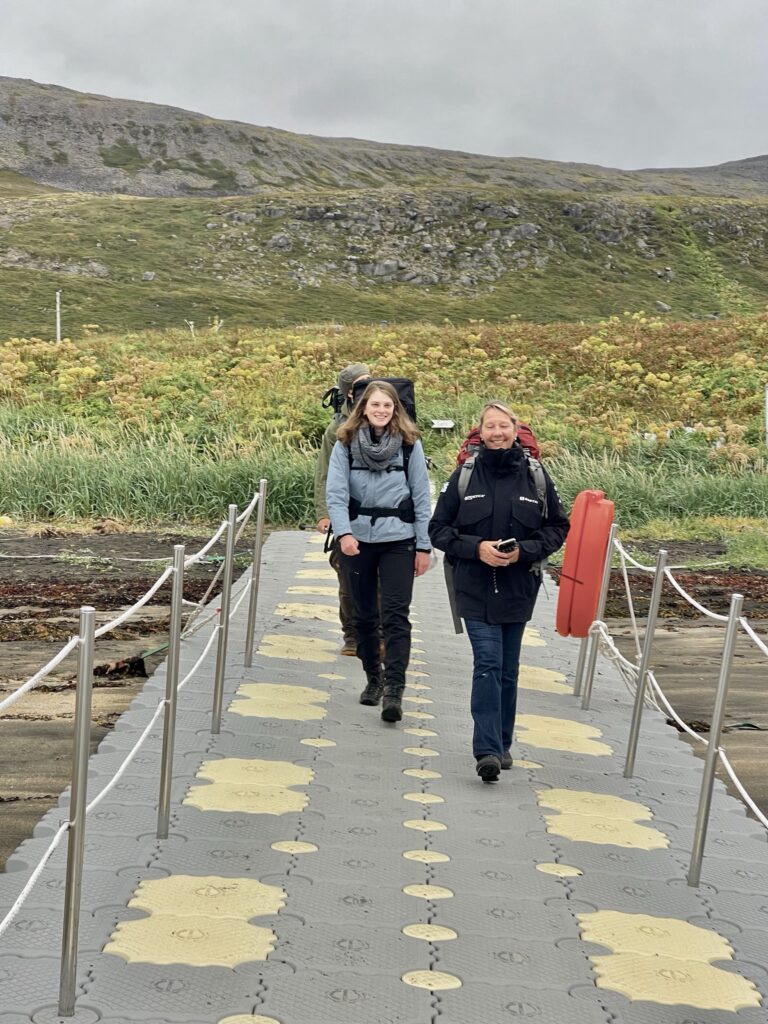

The truck was still there, untouched, and it felt like coming home after spending some wonderful time in that remote corner of Iceland. But we were not finished with the West Fjords. The West Fjords have a lot to offer, historically, culturally and the natural wonders. A small town called Flateyri is known for hosting the oldest store of Iceland (mainly like a bookstore) and used to be the home of a well known shark fisherman. A number of old port side house are still intact.

Flateyri is also known for a devastating snow avalanche in 1995, where 20 people perished during the nightly disaster and 32 homes were destroyed. It was the start of a nation wide plan from the Government to evaluate avalanche risks throughout the country and take preventive measures. In Flateyri, huge dikes and dams have been constructed to avoid new snow avalanches reaching the town.
In a harsh climate as that of Iceland, gardens with plants, flowers and exotic trees, are hard to imagine. The strong cold gail winds, make it hard for not native flora to grow. Still a pastor from a school and church, made it his life mission, to create a botanical garden in the middle of nowhere on a slight mountain slope. Surrounded by rock walls and over time protected from the wind by different species of trees, which were able to endure the cold and the wind, a garden divided in several square blocks came to life. Many different plants, scrub and tree species started to grow and still do.



Even some vegetables grow in the garden (and since some were ready to be harvested, some lettuce found a new home when we left). A small oasis in a raw wilderness and proof that different species of plants, trees and scrubs can grow in Iceland.
The pastor wanted to create awareness under his students for agriculture and botanica and he is still considered a pioneer in this field in Iceland.
Trying the drive around every peninsula of the West Fjords was in one occasion not possible. A narrow gravel road was rounding the tip of one of them, with steep cliff walls on both sides consisting of loose rocks. Due to rain, rocks had fallen down on the road and more could come down, so we decided to find a spot to turn around and go back. Not an easy feature on roads like these. But we found one and after some nerve breaking driving and turning, we paused, had some coffee and enjoyed the great views from the spot.


Iceland, or actually its waters, have for centuries attracted fishermen from the European continent. Fishermen from Spain (the Basque region) came all the way, to hunt for whales. There is a famous story about three Basque fishing boats getting shipwrecked and most of its crew survived. From two boats, the crew managed to get back to Spain. The third crew (32 souls) stayed much longer and due to their rude behaviors and because of accusations that they were trying to steal a ship, were killed by the Icelanders (1615). It was one of Icelands worst massacres. A memorial was placed in the old fish factory which we had visited earlier.
The French, British and Dutch also fished frequently in the Icelandic waters. A small remote graveyard is a small reminder of the French fishermen who died at sea. French fishing activity was so extensive that the French even had a hospital built on the east coast (in those days the best hospital of Iceland), for sick and injured fishermen. With the British the Icelanders had a hate and love relationship, whereby the Icelanders accusing the British to fish illegally within their territorial waters. This resulted in the so called “Cod Wars”. These “wars” were fought over fishing rights and the extended territorial waters and fishing zones of Iceland. Iceland (after threatening to leave the NATO), came out as the overall winner. For the British there was a devastating effect on the coastal fishing communities, with the loss of thousands of jobs.

The West Fjords look like a small part of Iceland, but following the entire coast line of all the peninsulas is a long ride, especially if there is so much to see. Even the beached oldest steel ship (which they have beached in the middle of nowhere and is slowly rusting away), or an old American Navy plane became tourist attractions. But what constantly sticks out is the natural beauty of the West Fjords, especially when the clouds and the sun light play their part to beautify the mountains, valleys and many beaches.

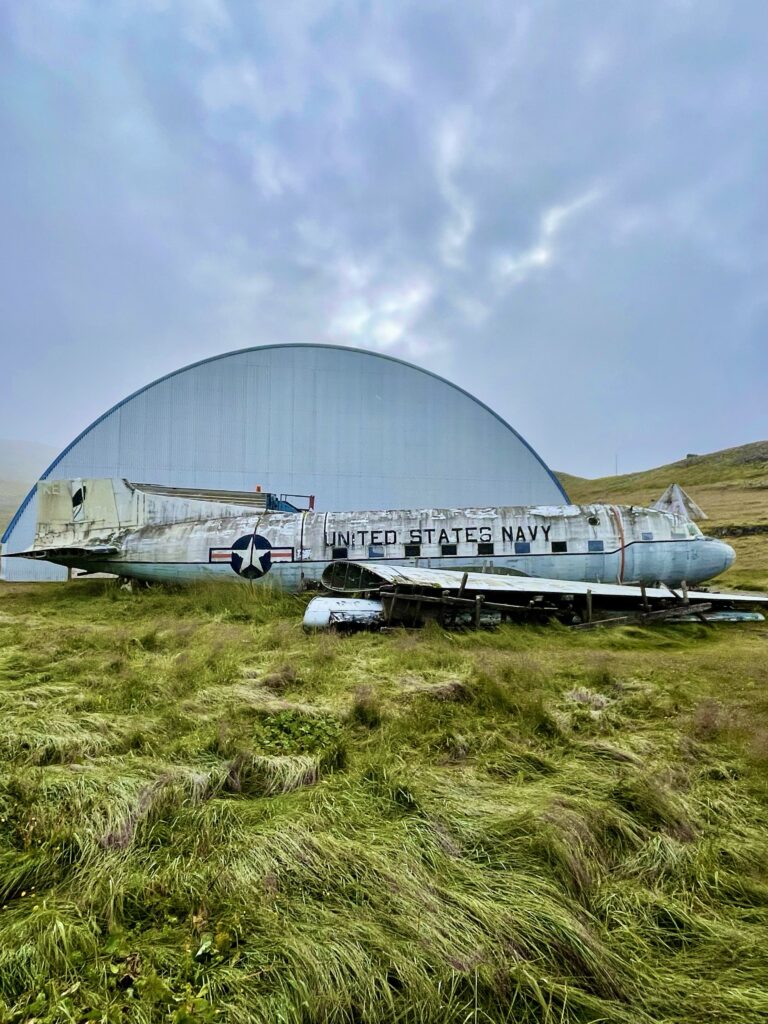


Reaching the last peninsulas, it seemed every kilometer we drove was getting better. Driving along long gravel roads, coming down in valleys and deltas, we passed long wide, light brown, yellow sand beaches (which could be Caribbean if not for the cold water and the absence of palm trees). Iconic little lighthouses keep ships at course and farmers have their home made handcraft for sale in defunct fridges along the road. To reach one of the most important historic places, which is located along a beach at the end of a secluded valley, we had to cross a narrow, steep, gravel road over a mountain in thick fog, which didn’t allow us to see left, right or front. We slowly crawled over the mountain, whereby sometimes the truck slid next to the road in soft gravel beds. On a long flat area on top, we almost decided to stop, but we drove on and descended down from the mountain. Coming down, the fog slowly disappeared and we starting to see things.






A wide area of grass land along sand dunes and the beach, it was full of historical spots of former farms. The valley had only one farm house occupied, but for the rest there was nothing. One of the earliest settlements of Iceland started here, in this remote and beautiful valley. It was also home for fishing stations, where men from all over the region came to fish during the season. Long rock walls, where fish was laid on to dry, where still visible.

Next morning, the sky was clear and the sun was shining. We walked the trails and passed the ruins of all the old farm houses and the fishing station and tried to visualize the life of the people who lived in this beautiful remote part of the West Fjords.


The last peninsula is also the home of the most western point of Iceland and Europe. But also the second highest cliff (450mtr) and the place where over 800.000 birds come during the nesting season. Hence a popular place for tourists and bird watchers alike. Where most visitors hike the first 100 meters along the cliff, we walked up to 2 kilometers along the edges of the cliff, which were very steep in both ways. A large eagle caught a young sea gull in front of us and flew away towards its own nest. This sight was the last “gift” from the West Fjords.





Driving towards the south to Snaefellsnes, towards the N1, we followed a main road, frequented by tourists coming from the capital. Where it was so easy to find a campsite in the wild in the West Fjords, it was now difficult, due to the many farms. But an old road section around the corner of a bay (which was replaced by a short cut bridge) and which was not in use anymore because it was partly destroyed by flooding, offered a great camp spot in front of a small waterfall. And yes, this was the end of our West Fjord tour.

